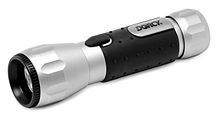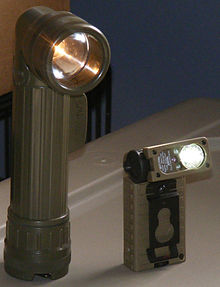Flashlight
This article needs additional citations for verification. (January 2010) |

A flashlight (usually called a torch outside North America) is a hand-held electric-powered light source. Usually the light source is a small incandescent lightbulb or light-emitting diode (LED). Typical flashlight designs consist of the light source mounted in a parabolic or other shaped reflector, a transparent lens to protect the light source from damage and debris, a power source (typically electric batteries), and an electric power switch.
While most flashlights are hand-held, there are head or helmet-mounted flashlights designed for miners and campers and battery-powered lights for bicycles. Some flashlights are powered by hand-cranked dynamos or electromagnetic induction or are recharged by solar power.
The name flashlight is used mainly in the United States and Canada. In other English-speaking countries, the most common term is torch or electric torch.
History
In 1896, the first dry cell battery was invented. Unlike previous batteries, it used a paste electrolyte instead of a liquid. This was the first battery suitable for portable electrical devices, as it did not spill or break easily and worked in any orientation.
On January 10, 1899, American Electrical Novelty and Manufacturing Company obtained U.S. Patent No. 617,592 (filed 12 March 1898) from David Misell, its English inventor.[1] This "electric device" designed by Misell was powered by "D" batteries laid front to back in a paper tube with the light bulb and a rough brass reflector at the end.[2][3] The company donated some of these devices to the New York City police, who responded favorably to them.[4]
These early flashlights ran on zinc–carbon batteries, which could not provide a steady electric current and required periodic 'rest' to continue functioning.[5] Because these early flashlights also used energy-inefficient carbon-filament bulbs, "resting" occurred at short intervals. Consequently, they could be used only in brief flashes, hence the popular name flashlight.[3]
Incandescent

Incandescent flashlights use incandescent light bulbss which consists of a glass bulb and a tungsten filament. The bulbs are under vacuum or filled with argon, krypton or xenon. Some high-power incandescent flashlight use a halogen lamp where the bulb contains trace of halogen such as iodine or bromine to improve the life and efficacy of the bulb.
LED

Developments in light-emitting diodes (LED)s have made practical flashlights that use LEDs instead of conventional light bulbs. LEDs have existed for decades, mainly used as low-power indicator lights. In 1999, Lumileds Corporation of San Jose, California United States, introduced the Luxeon LED, a high-power white-light emitter. This made possible LED flashlights with power and running time better than some incandescent lights. The first Luxeon LED flashlight was the Arc LS, designed in 2001.
LEDs can be significantly more efficient than incandescent lamps at lower power levels, so they use less battery energy than incandescent lightbulbs. Such flashlights have longer battery lifetimes than incandescent lamps of comparable light output. LEDs are also less fragile than conventional glass lamps.
Some LED flashlights electronically regulate the voltage supplied to the LEDs to stabilize light output as the batteries discharge. By contrast, the light output of non-regulated flashlights changes proportionally to the voltage supplied by the battery, resulting in a significant decline in output as battery voltage declines. LEDs also have the advantage of maintaining a specific color temperature regardless of input voltage or current, while the color temperature of an incandescent bulb declines with the power available.
LED flashlights may consume 1 watt or more from the battery, producing heat as well as light. Heat dissipation for the LED often indicates that LED flashlights have aluminum bodies to dissipate heat and can become warm during use.[6]
HID
Another less common type of flashlight uses a High Intensity Discharge (HID) lamp as the light source. HID is a type of gas discharge lamp that uses a mixture of metal halide salts and argon as a filler.
Some advantages of this design are that they produce more light than an incandescent flashlight using the same amount of electricity, the lamp will last longer and they are more shock resistant than a regular incandescent bulb, as they lack the relatively fragile electrical filament found in incandescent bulbs. However; they are much more expensive (due to the need for a ballast and other circuitry to start and operate the lamp).
Other designs

A penlight is a small, pen-sized flashlight, usually containing two AA batteries or AAA batteries. In some an incandescent light bulb has an integral lens that focuses the light, thus no reflector is built into the penlight. Others use incandescent bulbs mounted in reflectors, while LED lamps are becoming increasingly common. Low-cost units may be disposable with no provision for the user to replace batteries or bulbs, and are sometimes imprinted with advertising for promotional purposes.

A headlamp is a flashlight designed to be worn on the head. A headlamp usually consists of the light emitter at the front, with a battery pack also attached to the front or back. The battery pack may be attached to the back to improve balance.
Sometimes a tactical light is mounted to a handgun or rifle.[7]
Most flashlights are cylindrical in design, with the lamp assembly attached to one end. However, early designs came in a variety of shapes. Many resembled modern day lanterns, consisting largely of a box with a handle and the lamp attached to the front. Some others were made to have a similar appearance to candles.
Although most flashlights are designed in a manner that allows the user to replace the batteries and the bulb as needed, fully-sealed disposable flashlights do exist and various inexpensive keyring lights. When the batteries in a disposable flashlight are depleted or the bulb fails, the entire product usually is thrown away or recycled and a new one purchased to replace it.
Power sources
The most common power source for flashlights is the battery. Many types of batteries are suitable for use in flashlights, such as button cells, alkaline batteries, lithium batteries and rechargeable NiMH, NiCd batteries and lithium ion batteries. The choice of batteries will depend on the light source used, and will usually play a determining role in the size and shape of the flashlight.
Some flashlights are solar powered, using the energy generated from a solar cell to charge an on-board battery for later use.
Mechanical power
One type of dynamo-powered flashlight has a winding crank connected to a small electrical generator that charges a capacitor. Others generate electricity using electromagnetic induction. They use a strong permanent magnet that can freely slide up and down a tube, passing through a coil of wire as it does. Shaking the flashlight will charge a capacitor or a rechargeable battery that supplies a current to a light source. Such flashlights can be useful during an emergency, when batteries may not be available.
See also
- Carbide lamp
- Dyno torch
- Headlamps
- Arc Flashlight
- Maglite
- SureFire
- Streamlight
- Philips Lumileds Lighting Company
References
- ^ Patent number: 617592 by David Misell
- ^ History of Batteries (and other things)
- ^ a b Flashlight Museum
- ^ Steve Hathcock. "Give Me a Light". Island Breeze. Archived from the original on 2007-10-17. Retrieved 2007-02-05.
- ^ Brooke Schumm. "Nonrechargeable Batteries". The Electrochemistry Encyclopedia. Retrieved 2010-12-13.
- ^ Charles W. Wessner (ed) Partnerships for solid-state lighting: report of a workshop National Academies Press, 2002 ISBN 0309083192 page 54
- ^ Using Gun Lights
